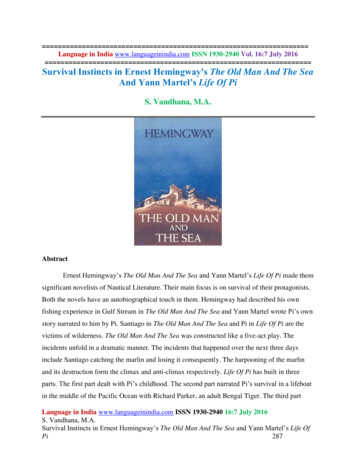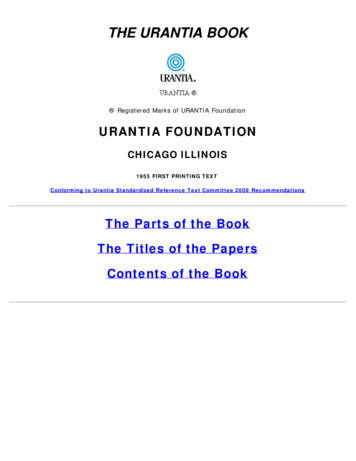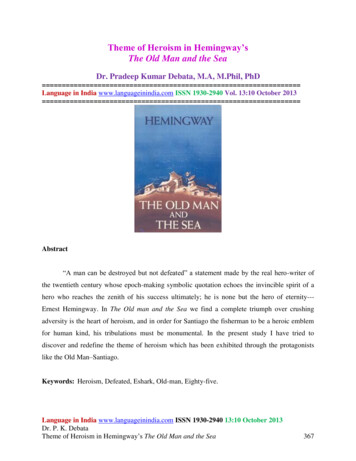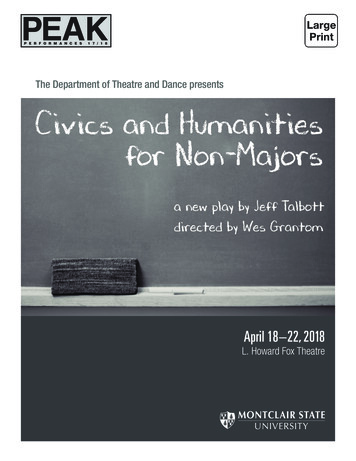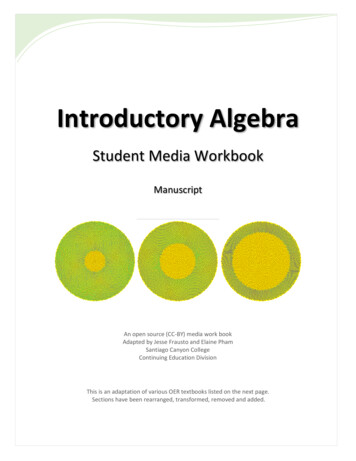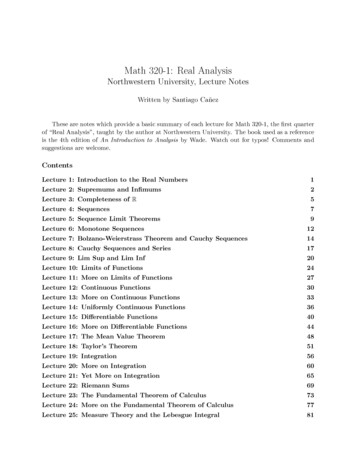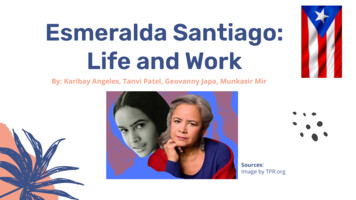
Transcription
Esmeralda Santiago:Life and WorkBy: Karibay Angeles, Tanvi Patel, Geovanny Japa, Munkasir MirSources:Image by TPR.org
Early Life Esmeralda Santiago was born in San Juan, Puerto Rico onMay 17, 1948. In 1961, she came to the United States at the age of 13 yearsold and initially faced discrimination and economicinstability as an migrant. She was the eldest child among her 11 siblings. She had tosupport her mother and siblings. She attended New York City’s Performing Arts High School,where she studied drama and dance. She experiencedstereotyping and discrimination based on skin color, cultureand even language (speaking in Spanish). She graduated from Harvard University in 1976 after eightyears of part-time at community colleges. Her writing career evolved from the work as a producer &writer of documentary and educational films.Sources:Text & ImageEsmeraldasantiago.com
Cultural Importance What does Esmeralda Santiago embody ? She embodies the struggle of many Puerto Ricans whohave migrated to the United States. Esmeralda Santiagoalong with her family migrated in the 1961 seeking bettereconomic stability. With her stories, she educates readers about the politicalhistory between the United States and Puerto Rico,revealing the tension between island-born Puerto Ricansand Nuyoricans in New York. She represents the voice of Latinx women through herstories empowering women and allowing them to findcomfort in their journeys and experiences as members ofthe Latinx community.Esmeralda Santiago’s Dream as a Young Woman To be fulfilled as a individual but most importantly as awoman. She achieved this by discovering her identity,and ultimately finding her calling through being a proudLatinx female writer.Sources:Text & ImageEsmeraldasantiago.com
Cultural Importance Speaks Out Against Stereotypes of the LatinxCommunity in her Books She wrote many books about her earlychildhood and experiences as a Latinx,voicing her struggle. When I was Puerto Rican América’s Dream.Her characters point out stereotypes in theLatinx community often ignored by thepublic. She has devoted her life to aidingvictims of domestic abuse, includingassisting with the establishment of aYouth Service Center and a batteredwomen's shelter in MassachusettsSources:Text & m
Continued. She Stands Up for What She Believed In She is involved in her community. Esmeralda Santiago isan active volunteer as a spokesperson on behalf of publiclibraries. She is a founder of a shelter for battered women and theirchildren in Massachusetts. She serves on The Boards of Organizations devoted to thearts and to literature, and speaks about the need toencourage and support the artistic development of youngpeople. As a cultural ambassador for the StateDepartment, she has traveled widely. She is aregular guest commentator on NPR's "All ThingsConsidered," "Morning Edition," "Latino USA," and"The Takeaway". Her essays and opinion pieceshave been widely published.Sources:Text & ImageConservancy.umn.eduNews.harvard.edu
Famous PublicationsWhen I was Puerto RicanAlmost a WomanReceived recognition forvoice “full of passion andauthority” by WashingtonPost Book World.A memoir of herswhich receivednumerous “Best ofthe year” mentions.19941996América’s DreamA woman that willnever forget her pasteven after she cameto the United Stateslooking for theAmerican dream.1999A Doll forNavidades2004The Turkish LoverA book illustratedfor children.2005A comprehensive,offensive seven-yearrelationship in Santiago’sthird memoir.Sources:Text & ImageEsmeraldasantiago.com
When I Was Puerto Rican The memoir starts with a six-year-old EsmeraldaSantiago living with her parents in Puerto Rico. Herfamily was struggling to survive and were living inpoverty. [1] She was also dealing with infidelity in her parent’smarriage. Her father continually leaving forced hermother to take the responsibility. [1] Her mother begins working at a factory, but shecontinually has to listen to society's taunts. Thisputs a lot of responsibility on Negi as she has totake care of her siblings. [2] Her family then moves to New York, where is facesdifferent obstacles. She expected the Americans totreat her like an outsider, but she realizes thatPuerto Ricans born in America don’t like to minglewith her. [1]Sources:Text & ImageEsmeraldasantiago.comSupersummary.com [1]Coursehero.com [2]
América’s Dream In this novel, América Gonzalez, lived in Puerto Ricowith her alcoholic mother and her teenagedaughter, Rosalinda. She worked as a housekeeperat a hotel. The father of her daughter, Correa, wasabusive to her. The relationship América had withher family members was toxic. She was offered a job in New York to work as ananny. She took this opportunity to escape from herfamily. As a result, América accepts the offer anddecides not to tell anyone. After some time, América tried to bring Rosalinda tothe United States. However, Correa tries to bring herback to Puerto Rico. Throughout the novel, América frees herself fromCorrea as she chooses to live life on her accord.Sources:Text & on.com
Main Themes Family: Throughout the novel, the theme is that América has a broken family.América relationship with her mom, her daughter and her partner is verycomplex and complicated. As readers, we don’t get to witness the sense ofattachment and love that normal families have. Each character in this novel hascertain attributes which contribute to the broken family. Freedom: América was offered a job in New York. The move to New York gaveher the liberty to leave Puerto Rico and be herself in New York. In New York,there was nothing holding her back because she didn’t have to worry aboutanyone but herself. As a result, she was freed from all her worries back in PuertoRico and found freedom in New York. American Dream: The move from Puerto Rico to New York was America’schance to live the American Dream. She took this opportunity to go live her ownlife in New York. Even though Puerto Rico is where she was from, she didn’t feelcomfortable there because of how she was treated. As a result, she came to theUnited States to live a better life. As a result, the migration to the United Statesled to another chapter in her life and opened doors for many opportunities.Source:TextGoodreads.com
Esmeralda Santiago InterviewSource:Kwls.org
Inspiration To The Latinx Community The retelling of her memories like When I was Puerto Rican. She hasinspired women to search for their identity and the overall Latinxreaders. Assimilation into American culture is a challenge for thiscommunity. This is followed by anxiety over abandoning theircultural and linguistic practices. Santiago's work is part of theautobiographical narrative movement for the Latinx Community. She also opposes discrimination. She has first-hand experiencewith many forms of discrimination herself. Instead of backingdown, she stood up for herself against the racist injustices. Sheencourages the Latinx community to stand up for themselves andacknowledge the differences that make us who we are. She is true to herself and through her characters shows howrespect and love for roots.She inspires us all, regardless of our generation. Assisting us inpursuing our goals, telling our stories, and preserving ourtraditions. Her accomplishments are a model of achievementachieved by personal honesty, uniqueness, and ideals. Her readersare encouraged to be brave about who they are and to use it totheir benefit.Sources:ImageNytimes.com
Thank You!
voice “full of passion and authority” by Washington Post Book World. 1996 América’s Dream A woman that will never forget her past even after she came to the United States looking for the American dream. Almost a Woman A memoir of hers which received numerous “Best of the year” mentions. A Doll
